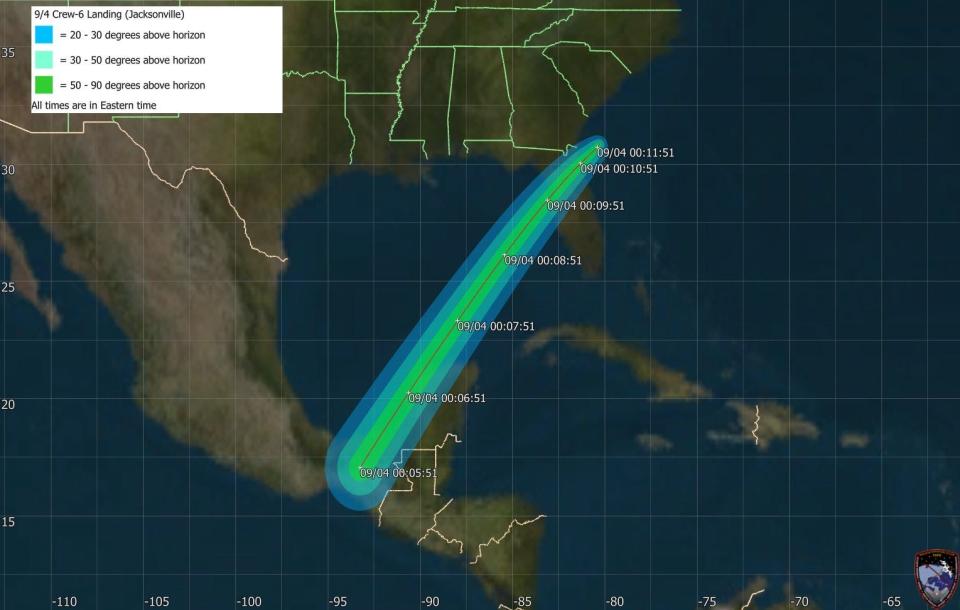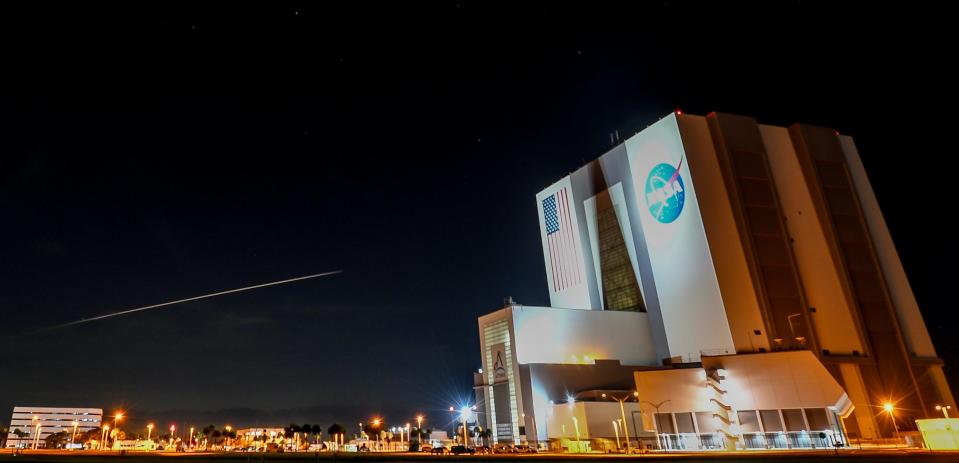NASA astronauts return to Earth in SpaceX capsule to wrap up 6-month station mission
MELBOURNE, Fla. – A SpaceX Crew Dragon capsule carrying three astronauts and one Russian cosmonaut splashed down off the coast of Jacksonville, Florida, wrapping up NASA's SpaceX Crew-6 mission early Monday.
The reentry could be seen by many across the southeast United States.
Between 12:05 a.m. and 12:17 a.m. EDT Monday, the Dragon Endeavour capsule arced across the night sky over the Gulf of Mexico and central northeast Florida, generating largely harmless but sometimes startling sonic booms that could be heard across the state.
The final splashdown in the Atlantic Ocean came shortly after at 12:17 a.m. off of the coast of Jacksonville. It marked the fourth trip to space and back for the Dragon Endeavour, having supported SpaceX's previous missions Axiom-1, Crew-2, and Demo-2.

Splashdown wraps up NASA's SpaceX Crew-6 ISS mission
Upon touchdown in the Atlantic Ocean, Crew-6 Commander Stephen Bowen said, "Thanks, SpaceX. We really appreciate all the support – from all the initial training through the launch, throughout the mission, keeping us abreast of the status of the vehicle, and all the support all the way down."
"This has been incredible," Bowen said. "Greatly appreciated. I look forward to working with you all again."
The conclusion of the nearly six-month science mission aboard the International Space Station began 17 hours prior to splashdown.
Welcome home, #Crew6!
After six months of science and discovery aboard the @Space_Station, our Crew-6 team splashed down at 12:17am ET (0417 UTC) and will be picked up shortly by recovery teams. pic.twitter.com/zf635dfUKF— NASA (@NASA) September 4, 2023
At 7:05 a.m. Sunday, NASA's Stephen Bowen and Woody Hoburg, the United Arab Emirates' Sultan Alneyadi, and Russian cosmonaut Andrey Fedyaev closed the hatch of their Dragon and departed the space station.
After spending most of the day circling the globe in orbit Sunday, the Dragon Endeavour autonomously performed the final of five deorbit burns at 11:24 p.m., committing it and its crew on the final descent back to Earth.
As it plunged through the Earth's atmosphere, the Dragon's heatshield endured temperatures of up to 3,500 degrees, which produced a layer of plasma around the capsule and knocked out ground communications with the crew for about seven minutes, a routine part of reentry.

Once SpaceX teams approached the bobbing capsule to confirm that no toxic propellants were leaking, it was rigged and hoisted up onto the deck of an awaiting recovery ship, which SpaceX calls "Megan," named after NASA astronaut Megan McArthur.
The crew of four would complete medical checkouts aboard the vessel before boarding a helicopter for the short jaunt back to Kennedy Space Center in Florida and an eventual return trip to NASA's Johnson Space Center in Texas.
Splashdown and recovery officially complete a mission dedicated to thousands of hours of science experiments and station maintenance.
To date, SpaceX has flown 11 human spaceflight missions overall. Eight of those missions have been contracted with NASA's Commercial Crew Program, while the other three flew private astronauts – Inspiration4, Axiom-1, and Axiom-2.
The latest mission, Crew-7, carried NASA astronaut Jasmin Moghbeli, European Space Agency astronaut Andreas Mogensen, Japan Aerospace Exploration Agency astronaut Satoshi Furukawa, and Roscosmos cosmonaut Konstantin Borisov to the space station just over a week ago.
When is the next launch?
Florida's next liftoff is slated to be a United Launch Alliance Atlas V rocket.
The national security mission, a joint effort between the U.S. Space Force and the National Reconnaissance Office, is set to carry secretive payloads to geostationary orbit. Last week, the NROL-107 mission was grounded when ULA returned the rocket back to the protection of the company's vertical integration facility until Hurricane Idalia passed.
A new launch date for that mission hasn't yet been identified.
"We will work with our customer and the range to confirm our next launch attempt and a new date will be provided once it is safe to launch," ULA said last week.
Meanwhile, another SpaceX Falcon 9 carrying a batch of the company's Starlink internet-beaming satellites could launch from Cape Canaveral Space Force Station late this week, but the company hasn't yet announced a targeted liftoff date or time.
Contact Jamie Groh at JGroh@floridatoday.com and follow her on X at @AlteredJamie.
This article originally appeared on Florida Today: NASA's SpaceX Crew-6 astronauts return to Earth after 6-month mission

